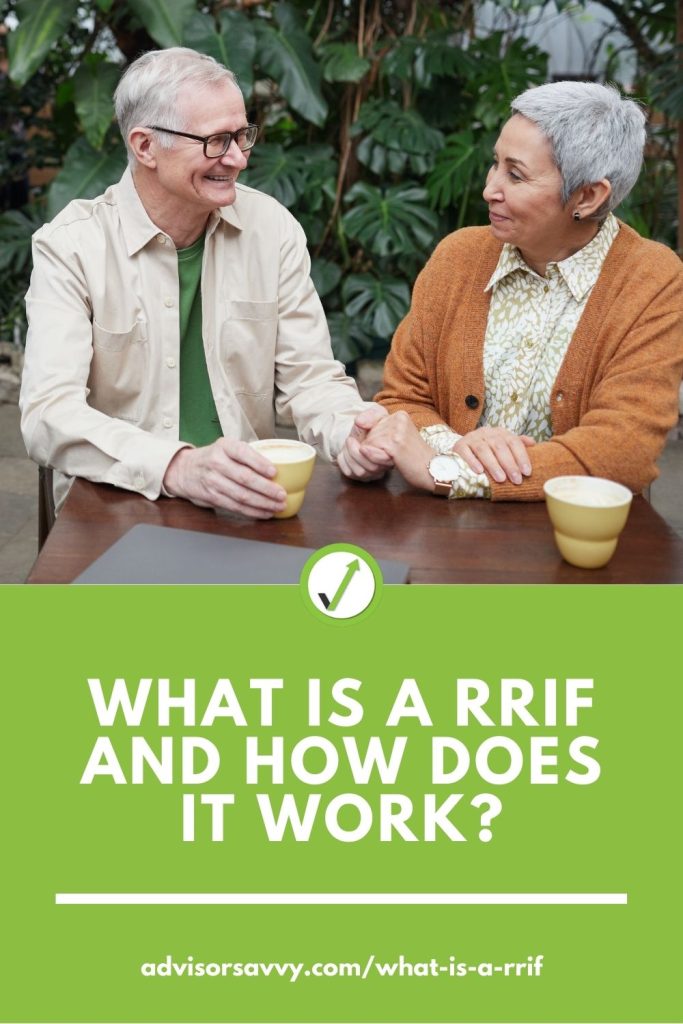
Have an RRSP? Well, one day — depending on how close you are to retirement — it’ll have to become an RRIF.
What do you think about when you hear the word ‘retirement‘?

[If you’re daydreaming now, we’ll wait…]
Certainly no more early mornings or commutes, but how about more travel? Maybe fully immersing yourself in what was once a weekend hobby like crafting, gardening, or writing.
Alas, a key piece in the retirement puzzle is, of course, money. You save and save and save for it — dutifully contributing to an RRSP.
Then what?
That’s where RRIFs come into play.
What is a RRIF?
RRIF stands for Registered Retirement Income Fund. Much like its name suggests, it gives you a steady income in retirement. Even better, they’re one of the most flexible and tax-effective ways of generating income in retirement.
Three reasons why RRIFs are great:
- Your money grows, tax-free
- How you invest the funds in your RRIF is totally up to you
- Withdrawal options are flexible
Self-directed RRIF vs. Advisor
You can take two approaches: An RRIF through a financial organization (called the “carrier”), or a self-directed RRIF. This second option is for those who want to build and manage their own investment portfolio. These investments must be qualified investments include mutual funds, stocks listed on a designated stock exchange, government and corporate bonds, and government-invested certificates (GICs).
FYI: The owner of an RRIF is considered the annuitant.
RRIF vs RRSP
The personal finance and investment world sure is an alphabet soup of acronyms, isn’t it?
In this case, it isn’t so much as one vs. the other. RRIFs are essentially a continuation of RRSPs, with some caveats.
Throughout your working years, you regularly contribute to an RRSP, strategically investing the funds. Since the cash in your RRSP is fully taxable if you withdraw it as cash, RRIFs come in when you’re ready to use the money — i.e. when you retire. At a certain point, when you’re winding down your work life, you need to convert your RRSP into an RRIF. All those savings are now going to become your taxable retirement income.
It’s also important to note that you can’t regularly contribute to RRIFs, though you can create and implement an investment strategy. Your RRIF can hold the same kinds of investments as your RRSP.
Once converted, your money will continue growing tax-free.
Converting your RRSP to RRIF
As mentioned above, your RRSP needs to be converted to an RRIF through a financial institute — typically the same one where their RRSP is held.
Note: the only other way an RRIF can be funded is through another RRIF owned by you or a deceased spouse/common-law partner, a registered pension plan or a deferred profit-sharing plan.
Where to open a RRIF
Setting up an RRIF is usually done through an application completed at any of the following:
- Banks and trust companies
- Credit unions and caisses populaires
- Insurance companies
- Mutual fund companies
- Investment firms
Your financial institution will be able to advise you on RRIFs, the investments they can contain, and help you set up a payment schedule.
Looking for a financial advisor to help you with RRIFs or any other financial matter? Fill out our questionnaire and we can help you find the best option for your unique situation.
When should you convert your RRSP to a RRIF?
This can theoretically be done at any time, but you’re required to convert your RRSP into income no later than December 31st of the year you turn 71.
How much do you have to withdraw from your RRIF each year?
Here, we need to highlight two things: First, the less you withdraw in the early years after setting up your RRIF, the longer your savings will last. Second, every year, you must withdraw a minimal amount from your RRIF. There’s no maximum. And yes, RRIF payments are considered taxable income.
One great aspect of RRIFs is that while you must take out a minimum amount annually, there’s still a large degree of flexibility. You can opt for monthly, quarterly, semi-annual, or annual withdrawals. If your situation changes, you can adjust the amount and frequency of payments, still keeping within your minimum.
Two significant RRIF rules to remember:
- If you do take out more than the minimum, you’ll have to pay withholding tax.
- Withdrawing must start in the year after you open it (i.e. the year you turn 72)
Do you have a spouse who is younger than you? If you have other sources of retirement income, calculating your minimum payment using their age will lower both the payment and subsequent income tax. It’ll also ensure that funds in your RRIF last longer.
RRIF withholding tax
As explained, withdrawing more than the minimum is subjected to withholding tax. The following rates apply only to the amount over the minimum:
- 10% on amounts up to $5,000
- 20% on amounts over $5,000 up to including $15,000
- 30% on amounts over $15,000
RRIF tax considerations
At the end of the tax year, you’ll receive a T4RIF slip to indicate the amount and type of income you got from the RRIF. Use this form your annual tax return.
What is the minimum RRIF withdrawal formula?
If you’re under 71 (i.e. set up your RRIF early) at the beginning of the year, the formula for your minimum payout is 1÷(90 – your current age).
For those 71 and older, the minimum withdrawal is based on a percentage of your RRIF assets. These percentages increase with your age, and have been established by the government.
RRIF withdrawal schedule
Age / Minimum amount
71 – 5.28%
72 – 5.40%
73 – 5.53%
74 – 5.67%
75 – 5.82%
76 – 5.98%
77 – 6.17%
78 – 6.36%
79 – 6.58%
80 – 6.82%
81 – 7.08%
82 – 7.38%
83 – 7.71%
84 – 8.08%
85 – 8.51%
86 – 8.99%
87 – 9.55%
88 – 10.21%
89 – 10.99%
90 – 11.92%
91 – 13.06%
92 – 14.49%
93 – 16.34%
94 – 18.79%
95 & over – 20.00%
RRIF payment calculators
You have options on options on options! Several financial institutions have online calculators to help you get a better idea of what your RRIF payments will look like. This one is very clean and simple, but here are some others you might want to try:
- BMO
- RBC
- TD
- The Co-operators
- Get Smarter About Money/Ontario Securities Commission
- Dynamic Funds
- Vancity Credit Union
- Servus Credit Union
What happens to my RRIF upon death?
Given that RRIFs come into play when you’re retiring and entering the later years of your life, naming a beneficiary is key.
Naming your spouse or a qualified beneficiary (children or grandchildren) means they’ll inherit your RRIF tax-free, and its value will not be included in the value of your estate. For your spouse or a child with a disability, these funds can be transferred to an RRSP, RDSP, or RRIF without triggering tax. If your spouse is over 71, it can only be transferred to an RRIF.
Naming your spouse the successor annuitant on your initial application means they’ll take over the RRIF and start receiving your payments.
If you don’t name a beneficiary, RRIFs are included when probate fees are calculated on your estate. The RRIF’s value will also be considered income on your final tax return.
If you are currently contributing to an RRSP, it’s comforting to know that you’ll be able to have a similarly tax-free option for growing your income once you’ve retired.
A reminder once again: If you’re looking for a financial advisor to help you plan your retirement, fill out our questionnaire. We’ll make sure you find the best option for your unique situation.
Related reading from our blog:
